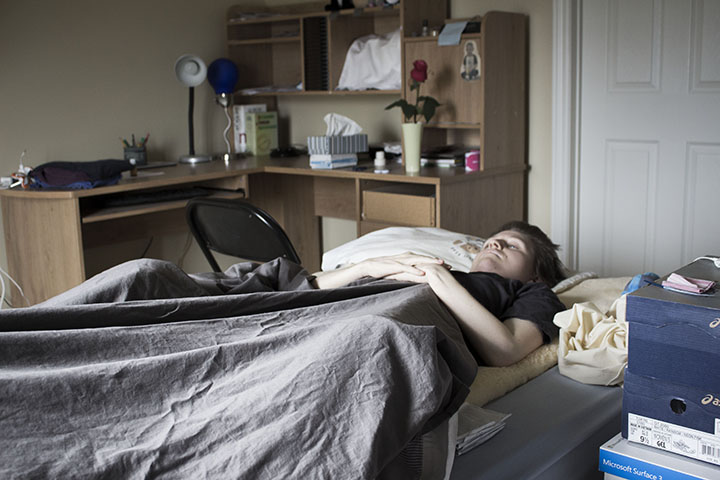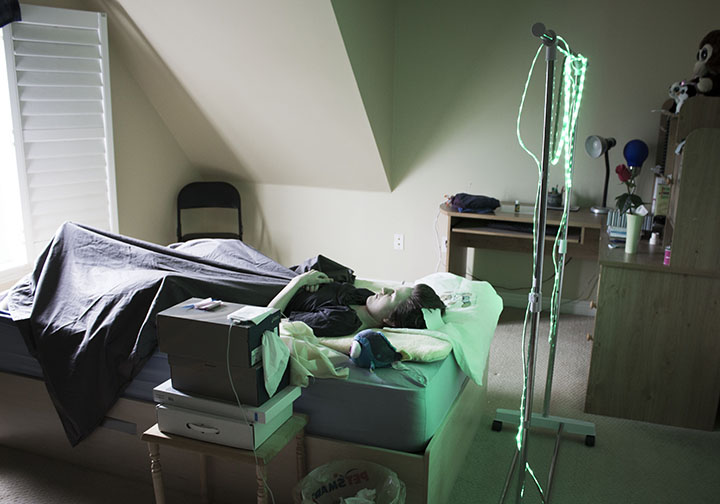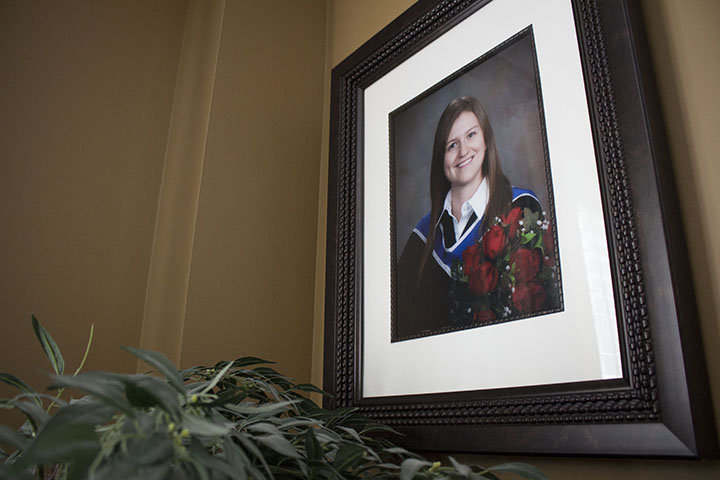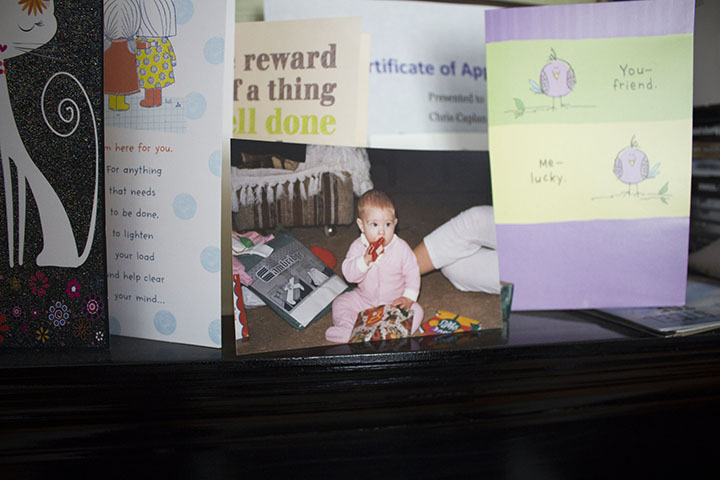What if you’re on the “right track,” months away from finishing your articling and becoming a lawyer, before those tracks twist and turn into a dark place.

What if your life derails on those tracks and comes crashing down like a freight train with no brakes?
What if that same train feels like it’s running you over, while at the same time burning you alive and stabbing you in the head with shards of glass?
For 29-year-old Rachael Caplan, this is a reality. She suffers from CRPS — Complex regional pain syndrome, a chronic and debilitating pain condition.
For the Toronto native, it all started about five years ago when she started feeling hip pain after running on the treadmill.
At first, she says, it didn’t really impact her life that much until it was too painful to sit down and write her law exams.
“Sometimes, when the pain is really, really bad, it feels like my hip is being torn from my body.”
It wasn’t until she saw 11 doctors and six health-care providers that she finally got a diagnosis. The thing about CRPS is that it’s not fully understood in the medical world.
What doctors do know however, is that diagnosing the chronic pain in the first six months is crucial if a patient wants to go into remission. If not, the constant pain endures.
Rachael went down every avenue possible, but it took more than two years before doctors understood she had CRPS.
“I feel like I fell through the cracks. Emotionally, it’s really overwhelming and crippling.”
Now, Rachael is bed-bound. The pain has spread throughout her body. She spends 23 hours a day in her single bed at her parents’ place, facing the window, as the world continues to turn.
What is CRPS
Complex regional pain syndrome, also called reflex sympathetic dystrophy syndrome is a chronic pain condition that affects the nerves. Dr. David Shulman, a pain specialist who focuses on CRPS, says the syndrome is kind of a mystery.
“It’s so devastating. People said outside of cancer, chronic pain and CRPS is one of the worst. People who have this disease have the worst quality of life,” Shulman says, who practices at Wilderman Medical Clinic in the Greater Toronto Area.
It’s not clear how people get it but it usually is believed to be caused by damage or malfunction of the central nervous system, which controls most functions of the body and mind.
“It can happen to anyone,” Shulman says, but it is slightly more common in women. The chronic pain can come out of the blue, but is usually activated by some sort of trauma.
“It usually starts after an injury from a broken bone. Instead of healing, it continues to be much worse as time goes on.”
The telltale symptom of CRPS includes continuous and constant pain that usually gets worse rather than better over time.
The pain can be anywhere in the body, but usually affects a limb. “It’s a very odd disease. It tends to spread,” Shulman says.
Patients can also feel like their skin is burning and can become so sensitive to touch, they can’t bear to keep their clothes on.
Other symptoms include swelling or stiffness of joints, not being able to move the affected body part, and changes in skin colour and temperature.

Get weekly health news
Over time, if the syndrome is not treated in the first six months, it can become a long-term disability, leaving people unable to move and in constant excruciating pain. There is no cure for CRPS.
“There is what they call a pain scale, which rates the most painful conditions. Labour is right up there, but CRPS is higher and it’s constant day and night.”
For Rachael, the pain is so bad that she got a buzz cut because brushing her hair is unbearable. She also has become extremely sensitive to sound. The sound of the lawnmower outside, or a plane flying over the house can cause piercing pain in Rachael’s head.
At home, Rachael’s parents whisper and watch TV on mute with subtitles. Dishes are washed on the rare occasion when Rachael can handle a little bit of sound.
“We’ve been going through this for the last five years – our job is to really make her comfortable from day to day – trying to avoid her pain increase, and keeping her positive,” Rachael’s father Marty Caplan says.
Treatments
For Rachael’s parents, seeing their daughter go through so much pain is a nightmare. Marty and Christine Caplan have become Rachael’s primary caregivers.
“It’s a horrifying experience but the most important task that we have and that we will ever have in our lives,” Marty says.
Luckily, Marty and Christine are able to work from home since they own an accountant firm. But even then, business has to remain extremely quiet.
Every day, Rachael’s parents prepare her food and water, and make sure temperatures are kept at a comfortable level to avoid triggering more pain. They sometimes read to Rachael, when she is having a good day.
Rachael says she has tried everything to find a treatment. Although it is believed that CRPS never goes away, patients can sometimes have the pain subside.
She’s tried every kind of painkiller, but to no avail. Physiotherapy, acupuncture, medical marijuana — nothing worked.
For a while, she tried hyperbaric oxygen therapy, which involved her going into a chamber and breathing in 100 per cent oxygen. It worked for a short period of time but it didn’t last.
But in recent months, Rachael has found solace in green light therapy. It hasn’t helped with the chronic pain, but it’s helped with her sensitivity to sound, tremendously.
Her family stumbled upon a study that showed green LED lights helped with chronic muscle pain in rats. Essentially, Rachael’s family set up a metal coat rack over her bed, and suspended green LED lights over her.
Rachael bathes in the green light with her eyes open, and it relieves some of the pain in her head. But in general, Rachael and her family say there isn’t enough research to truly understand what works and what doesn’t.
It’s been trial and error with Rachael and one thing she has learned, is that different treatments work for different people, she says. Overall, Rachael has depended on private pain clinics.
“It’s cost at least hundreds of thousands of dollars. It’s expensive,” Marty says.
“It’s difficult because doctors just don’t know what to do with it. It’s just a grey area. That’s why the government has frowned away from it. We need to raise awareness.”
In recent months, Rachael’s friends and family started a campaign to raise awareness on the rare chronic pain syndrome.
Since so little is known about CRPS, Rachael says she wants people to know the symptoms so perhaps someone who is just starting to feel the chronic pain will get treatment early, and better their chances of becoming pain-free.
Using hashtag #AceThisFire, people are uploading videos of themselves doing the ice challenge, which involves putting their hands in ice cold water, to mimic the feeling people with CRPS face every day.
Although Rachael can’t watch the videos, her mom listens to them with headphones and acts them out for her. Rachael says the videos make her cry, smile and laugh.
Chronic pain is becoming more common
More than 9,000 Canadians have been diagnosed with CRPS, which is just one of the many conditions of chronic pain. Dr. Shulman says the number sounds small but is really significant in terms of finding resources to help.
“Out of all the diseases that there are, this is the one that most affects people’s lifestyle and quality of life. It’s rare but it’s just devastating when it occurs,” Shulman says.
“They really can’t do anything. It has a chain reaction down the family. And of course, the cost to society is huge, because people when they became severely sick cannot work and are depending on medical services.”
In general, chronic pain is becoming more and more common, he added.
“Chronic pain is estimated to be anywhere from 20 to 30 per cent of the Canadian population. Availability of health pain clinics is problematic, because there are only so many of us.”
Shulman says the pain clinic he works at is so backed up, that his list for new consults starts in about nine months. “That’s pretty typical of pain clinics.”
The problem with that is, just like CRPS, many forms of chronic pain need to be treated as early as possible to increase the chances of minimizing pain.
Early diagnosis is key if you believe you have the condition, according to Helen Small, executive director of P.A.R.C., which helps provide information and awareness about CRPS.
“If you suspect that you have it, you should get it checked out because a lot of doctors don’t know about it. They don’t know to diagnose and they don’t know how to treat it,” Small said.
Rachael is hopeful for the future
For Rachael, although life sometimes feels like a derailed train, she says she’s going to continue to fight until she finds treatment that will help her go into remission.
The freight train that once came crashing down so quickly, is no longer an obstacle. She’s picking up the pieces, even if the pain is unbearable. Step by step, she’s going to get that train up and running again.
“I’m keeping my eye on the prize. When I get better, I’m right back out there,” Rachael says.
When Rachael gets better, she says she hopes to finish her five months of law articling and wants to be called to the bar. She’s not sure what she wants to do after that, but one thing is clear, she wants to help other people who suffer from chronic pain, and enjoy the small things in life.
“A friend once said to me, “Oh, your life is on hold.” I don’t feel that way because my life is not on hold. I’m growing older. The seasons are passing. But it’s not on hold. ”
“I can get better. I just really keep dreaming of the future.”
****If you believe you have CRPS, P.A.R.C helps patients find medical help. Early diagnosis is key. Get in contact with them here.
SOUND OFF: Global News wants to learn more about chronic pain and CRPS. If you want to share your story, please contact us at the form below.
Note: We may use your response in this or other stories. While we may contact you to follow up we won’t publish your contact info.


















Comments